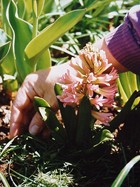Top Dressing
Treating lawns with just over a centimeter (half-inch) of compost serves as a very effective feeding when the ground has dried in the spring. By sifting the compost first, you can remove any unattractive large pieces or materials that may not be fully decomposed. These large pieces can be returned to the compost for further breakdown.
Side Dressing
You can also apply compost as a spot fertilizer. Scratch it lightly into the top layers of soil around the plant that needs a boost, and water deeply.
Compost "Tea"
Here's a tidy way to supply compost nutrients to house plants or to spot-fertilize seedlings. Soak a burlap bag or old pillowcase of compost in a pail of water until the liquid is tea-coloured. Or stir one part compost into three parts water and pour off the "tea". Using this liquid to water plants makes a difference, particularly in the middle of the warm growing season.
Mulch
Mulching should be done late in the spring when the ground is thoroughly warmed, but before summer's heat, to conserve moisture. Spread approximately 8 cm (3 inches) of compost on top of the soil around trees and shrubs, from near the base of the trunk out to the dripline. You can also mulch around vegetables and flowers as soon as the plants are approximately 8 cm (3 inches) high, to keep roots cool and discourage weeds.
Potting Soil
House plants, window boxes and hanging baskets will all benefit from a potting soil mixed with sifted compost. Compost alone can be used for growing vegetables in containers, and for starting plants from seed. For indoor use, you may want to sterilize compost in the oven for an hour at 95oC (200oF), but don't be alarmed by the (temporary) strong smell.
Using the Compost You Produce

Finished compost adds nutrients and organic matter to the soil, improving its texture and increasing its ability to hold air and water. Because it doesn't burn plant roots, large quantities of compost can be applied to the soil at any time.
Soil Improvement
Try digging several centimeters (one inch) of finished compost into a flower bed or vegetable garden before planting. How much you use will depend on how much you have available: the soil can use it all.
You can also give trees, shrubs, and nursery seedlings a good start by planting them in half-and-half soil and compost. New lawns will develop healthy roots to keep them green, if compost is dug into the soil before the grass seed is applied. When an established lawn suffers winter-kill, working some compost into the bald spots before seeding again is another good idea.
